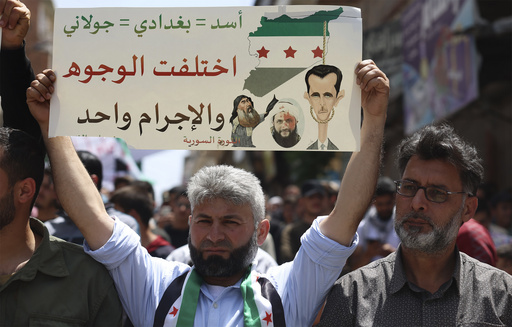BEIRUT, Lebanon (AP) — Living in a tent in rebel-held northwestern Syria, Rudaina al-Salim and her family struggle to find enough water for drinking and other basic needs such as cooking and washing. Their encampment north of the city of Idlib hasn’t seen any aid in six months.
“We used to get food aid, hygiene items,” said the mother of four. “Now we haven’t had much in a while.”
Al-Salim’s story is similar to that of many in this region of Syria, where most of the 5.1 million people have been internally displaced — sometimes more than once — in the country’s civil war, now in its 14th year, and rely on aid to survive.
U.N. agencies and international humanitarian organizations have for years struggled with shrinking budgets, further worsened by the coronavirus pandemic and conflicts elsewhere. The wars in Ukraine and Sudan, and more recently Israel’s war with Hamas in the Gaza Strip are the focus of the world’s attention.
Syria’s war, which has killed nearly half a million people and displaced half the country’s pre-war population of of 23 million, has long remained largely frozen and so are also efforts to find a viable political solution to end it. Meanwhile, millions of Syrians have been pulled into poverty, and struggle with accessing food and health care as the economy deteriorates across the country’s front lines.
Along with the deepening poverty, there is growing hostility in neighboring countries that host Syrian refugees and that struggle with crises of their own.
Aid organizations are now making their annual pitches to donors ahead of a fundraising conference in Brussels for Syria on Monday. But humanitarian workers believe that pledges will likely fall short and that further aid cuts would follow.
“We have moved from assisting 5.5 million a year to about 1.5 million people in Syria,” Carl Skau, the U.N. World Food Program’s deputy executive director, told The Associated Press. He spoke during a recent visit to Lebanon, which hosts almost 780,000 registered Syrian refugees — and hundreds of thousands of others who are undocumented.
“When I look across the world, this is the (aid) program that has shrunk the most in the shortest period for time,” Skau said.
Just 6% of the United Nations’ appeal for aid to Syria in 2024 has so far been secured ahead of Monday’s annual fundraising conference organized by the European Union, said David Carden, U.N. deputy regional humanitarian coordinator for Syria.
For the northwestern region of Syria, that means the U.N. is only able to feed 600,000 out of the 3.6 million people facing food insecurity, meaning they lack access to sufficient food. The U.N. says some 12.9 million Syrians are food insecure across the country.
The U.N. hopes the Brussels conference can raise more than $4 billion in “lifesaving aid” to support almost two-thirds of the 16.7 million Syrians in need, both within the war-torn country and in neighboring countries, particularly Turkey, Lebanon and Jordan.
At last year’s conference, donors pledged $10.3 billion — about $6 billion in grants and the rest in loans — just months after a 7.8 magnitude earthquake struck Turkey and much of northern Syria, killing over 59,000 people, including 6,000 in Syria.
For northwestern Syria, an enclave under rebel control, aid “is literally a matter of life and death” this year, Carden told the AP during a recent visit to Idlib province. Without funding, 160 health facilities there would close by end of June, he said.
The International Rescue Committee’s head for Syria, Tanya Evans, said needs are “at their highest ever,” with increasing numbers of Syrians turning to child labor and taking on debt to pay for food and basics.
In Lebanon, where nearly 90% of Syrian refugees live in poverty, they also face flagging aid and increasing resentment from the Lebanese, struggling with their own country’s economic crisis since 2019. Disgruntled officials have accused the refugees of surging crime and competition in the job market.
Lebanon’s bickering political parties have united in a call for a crackdown on undocumented Syrian migrants and demand refugees return to so-called “safe zones” in Syria.
U.N. agencies, human rights groups and Western governments say there are no such areas.
Um Omar, a Syrian refugee from Homs, works in a grocery store in the northern Lebanese city of Tripoli — an impoverished community that once warmly welcomed Syrian refugees.
For her work, she gets to bring home every day a bundle of bread and some vegetables to feed her family of five. They live rent-free in a tent on a plot of land that belongs to the grocery store’s owners.
“I have to leave the kids early in the morning without breakfast so I can work,” she said, asking to be identified only by her nickname, Arabic for “Omar’s mother.” She fears reprisals because of heightened hostilities against Syrians.
The shrinking U.N. aid they receive does not pay the bills. Her husband, who shares her fears for their safety, used to work as a day laborer but has rarely left their home in weeks.
She says deportation to Syria, where President Bashar Assad’s government is firmly entrenched, would spell doom for her family.
“If my husband was returned to Syria, he’ll either go to jail or (face) forced conscription,” she explains.
Still, many in Lebanon tell her family, “you took our livelihoods,” Um Omar said. There are also those who tell them they should leave, she added, so that the Lebanese “will finally catch a break.”
___
Albam reported from Harbnoush, Syria.
This website uses cookies so that we can provide you with the best user experience possible. Cookie information is stored in your browser and performs functions such as recognising you when you return to our website and helping our team to understand which sections of the website you find most interesting and useful.
